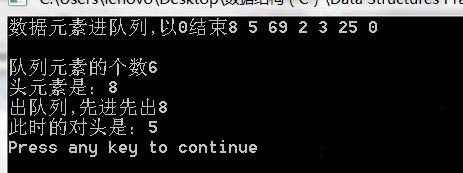生活中有很多队列的影子,比如打饭排队,买火车票排队问题等,可以说与时间相关的问题,一般都会涉及到队列问题;从生活中,可以抽象出队列的概念,队列就是一个能够实现“先进先出”的存储结构。队列分为链式队列和静态队列;静态队列一般用数组来实现,但此时的队列必须是循环队列,否则会造成巨大的内存浪费;链式队列是用链表来实现队列的。
|
1
2
3
4
5
6
7
8
9
10
11
12
13
14
15
16
17
18
19
20
21
22
23
24
25
26
27
28
29
30
31
32
33
34
35
36
37
38
39
40
41
42
43
44
45
46
47
48
49
50
51
52
53
54
55
56
57
58
59
60
61
62
63
64
65
66
67
68
69
70
71
72
73
74
75
76
77
78
79
80
81
82
83
84
85
86
87
88
89
90
91
92
93
94
95
96
97
98
99
100
101
102
103
104
105
106
107
108
109
110
111
112
113
114
115
116
117
118
119
120
121
122
123
124
125
126
127
128
129
130
131
132
133
134
135
136
137
138
139
140
141
142
143
144
145
146
147
148
149
150
151
152
153
154
155
156
157
158
159
160
161
162
163
164
165
166
167
168
169
170
171
172
173
174
175
176
177
178
179
180
181
182
183
184
185
186
187
188
189
190
191
192
193
194
195
196
197
198
199
200
201
202
203
204
205
206
207
208
209
210
211
212
213
214
215
216
217
218
219
220
221
222
223
|
#ifndef SQQUEUE_H_INCLUDED #define SQQUEUE_H_INCLUDED /* 防止重复包含 */ ////////////////////////////////////////// //包含头文件 #include <stdlib.h> #include "ds.h" // OK, Status 等定义 //数据元素的类型(缺省使用int型) #ifndef ElemType #define ElemType int #define USE_DEFAULT_ELEMTYPE /* 使用缺省类型的标志 */ #endif //ElemType ////////////////////////////////////////// //循环队列的存储结构 #define MAXQSIZE 500/* 循环队列的最大容量 */ typedef struct { /* TODO (#1#): 这里完成循环队列的类型定义 */ ElemType *base; int front; int rear; //.................................... } SqQueue; ////////////////////////////////////////// //循环队列的基本操作 //构造一个空队列Q Status InitQueue(SqQueue &Q) { /* TODO (#2#): 构造空队列 */ Q.base=(ElemType*)malloc(MAXQSIZE *sizeof(ElemType)); if(!Q.base)exit(OVERFLOW); QQ.front=Q.rear =0; return OK; //TODO: 替换这行代码,以下同 //.................................... } //销毁队列Q // 前提:队列Q已存在 Status DestroyQueue(SqQueue &Q) { /* TODO (#3#): 销毁队列 */ free(Q.base); Q.base=NULL; Q.front=0; Q.rear=0; return OK; //.................................... } //将队列Q清为空队列 // 前提:队列Q已存在 Status ClearQueue(SqQueue &Q) { /* TODO (#4#): 清空队列 */ Q.base=0; Q.rear=0; return OK; //.................................... } //若队列Q为空,则返回TRUE,否则FALSE // 前提:队列Q已存在 Status QueueEmpty(SqQueue Q) { /* TODO (#5#): 判断队列是否为空 */ if(Q.front==Q.rear) return OK; else return ERROR; //.................................... } //返回队列Q的元素个数,即队列长度 // 前提:队列Q已存在 int QueueLength(SqQueue Q) { /* TODO (#6#): 返回队列长度 */ return (Q.rear-Q.front+MAXQSIZE)%MAXQSIZE; //.................................... } //取队列Q头元素用e返回 // 前提:队列Q存在且非空 Status GetHead(SqQueue Q,ElemType &e) { /* TODO (#7#): 取队头元素存入e */ if(Q.rear==Q.front) return ERROR; e=Q.base[Q.front]; //e=*(Q.base+Q.front); return OK;//返回操作状态(成功:OK,失败:ERROR) //.................................... } //插入元素e作为队列Q的新的队尾元素 // 前提:队列Q存在且未满 Status EnQueue(SqQueue &Q, ElemType e) { /* TODO (#8#): 元素e入队列 */ if((Q.rear+1)%MAXQSIZE==Q.front) return ERROR; //e=*(Q.base +Q.rear); Q.base[Q.rear]=e; Q.rear=(Q.rear+1)%MAXQSIZE; return OK;//返回操作状态(成功:OK,失败:ERROR) //.................................... } //删除队列Q的队头元素,并用e返回 // 前提:队列Q存在且非空 Status DeQueue(SqQueue &Q, ElemType e) { /* TODO (#9#): 出队列存入e */ if(Q.front==Q.rear) return ERROR; //e=*(Q.base+Q.front); e=Q.base[Q.front]; Q.front=(Q.front+1)%MAXQSIZE; return OK;//返回操作状态(成功:OK,失败:ERROR) //.................................... } ////////////////////////////////////////// //TODO: 定义好 SqQueue 类型后使用 QueueView 函数 /****** //TODO: 删除此行以便使用QueueView() #include <stdio.h> //查看队列状态(调试用) void QueueView(SqQueue Q) { extern void PrintElem(ElemType e);//打印数据用 int i=0; if(Q.front<0||Q.front>=MAXQSIZE||Q.rear<0||Q.rear>=MAXQSIZE){ printf("队列未初始化\n"); return ; } printf("---Queue View---\n"); printf("front=%d , rear=%d\n", Q.front, Q.rear); if(Q.rear>=Q.front) { printf("..... ......\n"); for(i=Q.front; i<Q.rear; i++) { printf("%5d\t", i); PrintElem(Q.base[i]); printf("\n"); } if(i<MAXQSIZE) printf("..... ......\n"); } else { for(i=0; i<Q.rear; i++) { printf("%5d\t", i); PrintElem(Q.base[i]); printf("\n"); } printf("..... ......\n"); for(i=Q.front; i<MAXQSIZE; i++) { printf("%5d\t", i); PrintElem(Q.base[i]); printf("\n"); } } printf("--- view end ---\n"); } ******/ //TODO: 删除此行以便使用QueueView() //取消ElemType的默认定义,以免影响其它部分 #ifdef USE_DEFAULT_ELEMTYPE #undef ElemType #undef USE_EFAULT_ELEMTYPE #endif #endif //SQQUEUE_H_INCLUDED #include <stdio.h> #include <stdlib.h> #include "sqqueue.h" //初始化系统 void Finalize(SqQueue &q); //////////////////////////////////////////// //主程序 int main() { SqQueue q; //循环队列 int x; //系统初始化 InitQueue(q); printf("数据元素进队列,以0结束"); scanf("%d",&x); while(x!=0){ EnQueue(q,x); scanf("%d",&x); } printf("\n队列元素的个数"); printf("%d",QueueLength(q)); printf("\n头元素是:"); if(!QueueEmpty(q)){ if(GetHead(q,x)==OK) printf("%d",x); } printf("\n出队列,先进先出"); if( DeQueue(q,x)==OK) printf("%d",x); printf("\n此时的对头是:"); if(!QueueEmpty(q)){ if(GetHead(q,x)==OK) printf("%d\n",x); } } |
实现的效果:

以上所述就是本文的全部内容了,希望大家能够理解。














